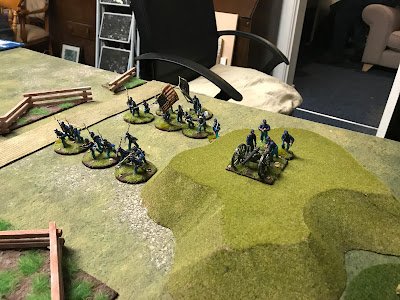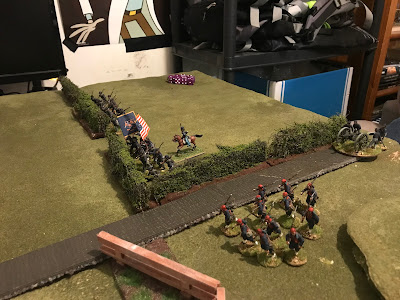Game 1
I played in this game commanding the Union forces. We both pushed forward with the Rebs moving first and grabbing the house while their artillery tore big holes in my lead unit.

This prompted a change of approach - I looked to surround the house and pour in fire from three sides while my artillery picked off units the backfield so they could not reinforce the defenders. This proved pretty successful.
 Late-on I went short on ammo and so the Rebs launched a charge that pushed back the unit defending my right. I was able to fight back and ended the game holding the house.
Late-on I went short on ammo and so the Rebs launched a charge that pushed back the unit defending my right. I was able to fight back and ended the game holding the house.  |
| An attack goes in |
Game 2
In this Union forces held back looking to adopt a defensive line near the house without really looking to capture it.
 The Confederates attacked with their usual gusto but suffered in the face of accurate Federal firing. Neither side held the house at the end, but the Confederates had taken the greater losses.
The Confederates attacked with their usual gusto but suffered in the face of accurate Federal firing. Neither side held the house at the end, but the Confederates had taken the greater losses.  |
| The thin blue line |
Game 3
In this game it was Union troops who were the more aggressive. Darkness fell early on this table so there was no result, but the Union had probably made the most ground, but we'll never know if they were over extended or in a winning position.
 |
| Union attacks |







Unless you want to re-create Pickett's Charge, you need more terrain. Many ACW battles were fought at point blank range due to concealment or other factors. All targets at more than 12" range require 3 hits (4 for Lt Inf, skirmishers or artillerists) to remove a casualty. It may be worth it to screen your main units with skirmishers. The rules are for small unit Regt or Bn) actions. At the beginning, Batteries were attached to Brigades. Later they were concentrated at Divion or Corp level.
ReplyDeleteAlso, Lion Rampant can be dominated by Archers or Crossbowmen.
Ignore any of my comments that have been contradicted by the Author.